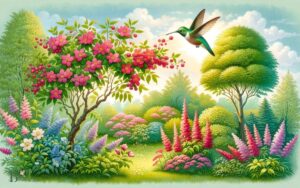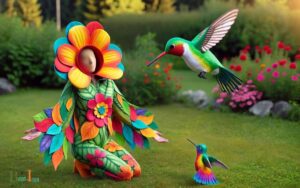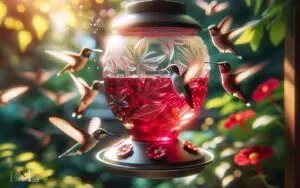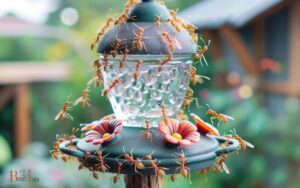Do Mimosa Trees Attract Hummingbirds? Yes!
Yes, Mimosa trees (Albizia julibrissin) are known for their attractive, nectar-rich flowers that can draw hummingbirds to your garden.
The showy pink blossoms provide an excellent food source for these birds throughout the blooming season.
Mimosa trees, also known as silk trees, feature lush, fern-like foliage and distinctive fluffy pink flowers that appear in the summer.
These flowers are rich in nectar, which is highly appealing to hummingbirds, alongside other pollinators like bees and butterflies.
Hummingbirds rely on nectar for energy due to their high metabolism and are naturally attracted to areas where food sources are abundant.
The bright coloration and the arrangement of the mimosa flowers allow for easy access to the nectar, making these trees an ideal spot for hummingbirds to feed.
The Mimosa tree’s vibrant blossoms not only add aesthetic appeal to your landscape but also create a hummingbird-friendly environment, supporting the ecosystem.
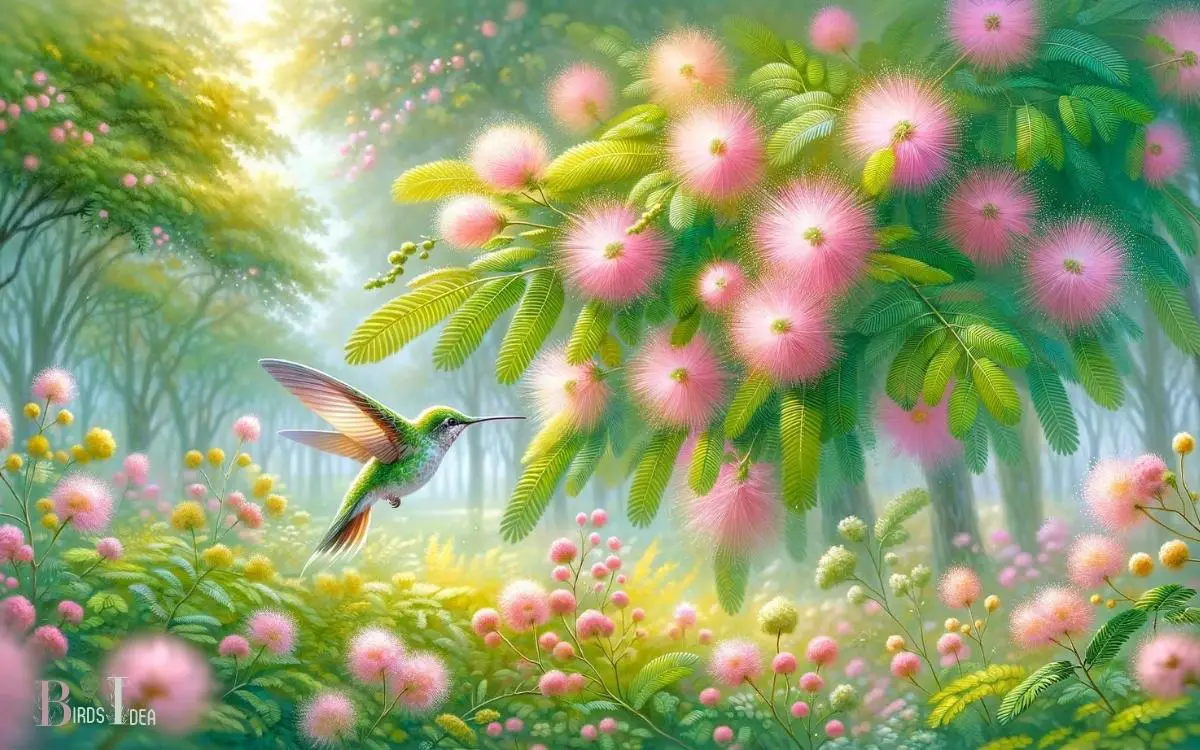
Key Takeaway
The Unique Characteristics of Mimosa Trees
The blooming of mimosa trees is a striking feature that distinguishes them from other species.
These trees, also known as silk trees, produce fluffy, pink, and fragrant flowers that bloom in the early summer.
The delicate fern-like leaves of the mimosa tree fold up at night, giving them a unique characteristic that adds to their appeal.
With a relatively short stature, typically reaching 20-35 feet in height, mimosa trees are often sought after for their ornamental value in landscaping.
Their rapid growth and ability to thrive in various soil types make them popular choices for adding beauty and shade to gardens and yards.
Mimosa trees have a distinctive and graceful appearance, making them stand out in any landscape.
The Allure of Mimosa Tree Flowers
Although relatively small, mimosa tree flowers are a magnet for various pollinators and birds due to their vibrant color and sweet aroma.
The allure of these flowers lies in their unique characteristics, which make them irresistible to a variety of creatures:
- Vibrant Color: Mimosa tree flowers boast a striking pink hue that stands out in any garden or natural setting, attracting attention from afar.
- Sweet Aroma: The flowers emit a delicate, sweet fragrance that beckons pollinators like bees, butterflies, and hummingbirds.
- Abundant Nectar: Mimosa tree flowers produce ample nectar, providing a rich food source for hummingbirds and other nectar-feeding birds.
These factors combine to make mimosa tree flowers a captivating and vital component of the ecosystem, drawing in a diverse array of wildlife.
The Nectar of Mimosa Tree Blossoms
With its abundant nectar, mimosa tree blossoms serve as a valuable food source for hummingbirds and other nectar-feeding birds, drawing them in with their sweet fragrance and vibrant color.
The nectar produced by these blossoms is high in sucrose, making it an energy-rich source for the birds that feed on it.
Mimosa tree nectar is also known for its high amino acid content, providing essential nutrients for the birds.
The flowers produce nectar in specialized glands called nectaries, which are located at the base of the flower.
This nectar is accessible through the flower’s long tubular structure, which is well-suited for the long beaks of hummingbirds.
The abundance of nectar in mimosa tree blossoms makes them an attractive and important resource for hummingbirds and other nectar-feeding birds.
Hummingbird Behavior and Preferences
Hummingbirds frequently prefer mimosa tree blossoms due to their high nectar content and accessibility through the flower’s long tubular structure, which suits their long beaks.
Hummingbird behavior and preferences related to mimosa trees are fascinating and can be summarized as follows:
- Feeding Patterns: Hummingbirds are attracted to the bright pink, fragrant flowers of mimosa trees and often exhibit territorial behavior around these food sources.
- Foraging Efficiency: The tubular shape of the mimosa flower allows hummingbirds to feed more efficiently, as it matches the length of their bills and enables them to access nectar more easily.
- Seasonal Dependence: Hummingbirds rely on the nectar from mimosa tree blossoms, particularly during the late spring and early summer when these flowers are abundant.
Understanding these behaviors can help in attracting and supporting hummingbirds in local environments.
The Potential Attraction of Hummingbirds
Mimosa trees are known for their potential to attract hummingbirds due to the high nectar content and accessibility of their flowers.
Hummingbirds are naturally drawn to flowers with high nectar levels and bright colors, making the delicate pink blooms of the mimosa tree an appealing food source for these tiny birds.
Key Factors Making Mimosa Trees Attractive to Hummingbirds
| Factors | Description |
|---|---|
| Abundant Nectar | Rich, sweet nectar source for hummingbirds. |
| Colorful Blooms | Vibrant flowers that catch hummingbirds’ attention. |
| Convenient Structure | Easily accessible for hummingbirds to perch and feed. |
| Blooming Seasonality | Consistent blooms providing a year-round food source. |
These factors combined make mimosa trees a potential hotspot for hummingbird activity. As a result, planting mimosa trees in gardens or green spaces can be a strategic way to attract and support these beautiful, energetic birds.
Tips for Encouraging Hummingbird Visits
One effective way to encourage hummingbird visits to your garden is by providing a variety of nectar-rich flowers and maintaining clean, well-stocked feeders.
Here are some additional tips for encouraging hummingbird visits:
- Plant a diverse selection of flowers that bloom at different times throughout the year, such as bee balm, trumpet vine, and salvia. This provides a continuous nectar source for hummingbirds.
- Keep the feeders clean and filled with fresh nectar. A solution of 4 parts water to 1 part white sugar closely mimics natural nectar and is safe for hummingbirds.
- Create a welcoming environment by adding perches for hummingbirds to rest and observe their surroundings. They are more likely to frequent a garden where they feel safe and comfortable.
Other Benefits of Planting Mimosa Trees
Attracting hummingbirds to your garden not only adds beauty and vitality, but planting mimosa trees also provides other benefits that contribute to a thriving ecosystem.
Mimosa trees are nitrogen-fixing plants, which means they can improve the soil quality by adding nitrogen, an essential nutrient for plant growth.
Additionally, their nectar-rich flowers attract various pollinators, including bees and butterflies, promoting biodiversity in the garden.
Mimosa trees also offer shade and shelter for small birds and other wildlife, creating a more hospitable environment.
Their rapid growth and dense foliage make them effective windbreaks, reducing soil erosion and protecting other plants in the garden.
Overall, planting mimosa trees can enhance the ecological balance and resilience of your garden.
As such, creating a hummingbird-friendly environment involves considering these multiple benefits alongside specific strategies to attract and support hummingbirds.
Creating a Hummingbird-Friendly Environment
Creating a hummingbird-friendly environment involves understanding the benefits of planting mimosa trees, selecting plants that attract hummingbirds, and providing nectar-rich flowers to entice these beautiful birds.
Mimosa trees offer a source of food and shelter for hummingbirds, while specific plant selections like bee balm, salvia, and penstemon can further enhance the environment.
Additionally, incorporating nectar-producing flowers such as trumpet vine, columbine, and cardinal flower can play a pivotal role in attracting hummingbirds to the area.
Mimosa Tree Benefits
Mimosa trees provide a hospitable environment for hummingbirds due to their abundant nectar and attractive, fragrant blooms.
These benefits make them an excellent addition to any garden aiming to attract and support hummingbirds.
Here are some ways in which mimosa trees contribute to creating a hummingbird-friendly environment:
- Abundant Nectar: The profuse nectar production of mimosa trees serves as a vital food source for hummingbirds, providing them with the energy they need for their active lifestyles.
- Attractive, Fragrant Blooms: The vibrant and aromatic flowers of mimosa trees act as a natural magnet for hummingbirds, drawing them into the garden and encouraging their presence.
- Shelter and Nesting Sites: The dense foliage of mimosa trees offers shelter and potential nesting sites for hummingbirds, enhancing their overall habitat.
With these advantages, mimosa trees play a crucial role in creating a welcoming environment for hummingbirds.
Hummingbird-Friendly Plant Selection
The selection of plants for a hummingbird-friendly environment should prioritize those with vibrant, nectar-rich flowers to attract and sustain these energetic birds.
When creating a hummingbird-friendly garden, consider incorporating a variety of flowers that bloom at different times throughout the year to provide a consistent nectar source.
Here’s a guide to some popular hummingbird-friendly plants:
| Plant | Flower Color | Bloom Time |
|---|---|---|
| Bee Balm | Red, Pink, Purple | Summer |
| Trumpet Vine | Orange, Red | Summer-Fall |
| Salvia | Red, Pink, Purple | Spring-Fall |
| Coral Honeysuckle | Orange, Red | Spring-Fall |
These colorful and nectar-rich plants are sure to attract and delight hummingbirds in your garden.
Attracting Hummingbirds With Nectar
How can nectar-rich plants contribute to creating a hummingbird-friendly environment? Nectar-rich plants play a crucial role in attracting hummingbirds by providing them with a natural food source.
Creating a hummingbird-friendly environment involves strategically selecting and cultivating nectar-rich plants that will entice these tiny birds to visit and linger in a specific area.
Here are three essential factors to consider when using nectar to attract hummingbirds:
- Plant Selection: Choose a variety of nectar-rich plants with different blooming periods to ensure a continuous nectar supply throughout the seasons.
- Location: Position nectar-rich plants in areas that offer protection from strong winds and predators while providing easy visibility and access for hummingbirds.
- Maintenance: Regularly maintain and prune nectar-rich plants to promote healthy growth and continuous nectar production, ensuring a reliable food source for hummingbirds.
Conclusion
Despite their vibrant and nectar-filled blossoms, mimosa trees may not always attract hummingbirds.
While these trees have the potential to entice these tiny birds, it ultimately depends on the local hummingbird population and their preferences.
So, while planting a mimosa tree may seem like a surefire way to attract hummingbirds, it’s not always guaranteed.
Sometimes, nature has its own plans, and what seems like a perfect match may not always work out as expected.


